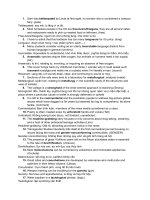Basic ielts reading practice 1
Bạn đang xem bản rút gọn của tài liệu. Xem và tải ngay bản đầy đủ của tài liệu tại đây (39.42 KB, 3 trang )
Cultural expectations and leadership
Read an article about the different cultural expectations of a leader to practise and improve your reading skills.
Before reading
Do the preparation task first. Then read the text and do the exercises.
Match the definitions (a–h) with the vocabulary (1–8).
Vocabulary Definition
1. …… vague
a. to perform or complete a job or activity
2. …… to carry out a task
b. unclear, not specific or definite
3. …… democratic
c. a system where members are ranked according to
status
4. …… a hierarchy
5. …… to come up with
6. …… resentment
7. …… to be perceived
8. …… to have initiative
or authority
d. based on the idea that everyone is equal and should
be
involved in making decisions
e. to think of something such as an idea or plan
f. to be seen or understood in a certain way
g. to have the ability to take action without someone
telling
you what to do next
h. dissatisfaction and bad feelings from being treated
unfairly
Reading text: Cultural expectations and leadership
Gabriela worked for a multinational company as a successful project manager in Brazil and was transferred to manage a
team in Sweden. She was excited about her new role but soon realised that managing her new team would be a
challenge.
Despite their friendliness, Gabriela didn’t feel respected as a leader. Her new staff would question her proposals openly
in meetings, and when she gave them instructions on how to carry out a task, they would often go about it in their own
way without checking with her. When she announced her decisions on the project, they would continue giving their
opinions
as if it was still up for discussion. After weeks of frustration, Gabriela emailed her Swedish manager about the issues she
was facing with her team. Her manager simply asked her if she felt her team was still performing, and what she thought
would help her better collaborate with her team members. Gabriela found her manager vague and didn’t feel as if he
was managing the situation satisfactorily. What Gabriela was experiencing was a cultural clash in expectations. She was
used to a more hierarchical framework where the team leader and manager took control and gave specific instructions
on how things were to be done. This more directive management style worked well for her and her team in Brazil but
did not transfer well to her new team in Sweden, who were more used to a flatter hierarchy where decision making was
more democratic. When Gabriela took the issue to her Swedish manager, rather than stepping in with directions about
what to do, her manager took on the role of coach and focused on getting her to come up with her own solutions
instead.
Dutch social psychologist Geert Hofstede uses the concept of ‘power distance’ to describe how power is distributed and
how hierarchy is perceived in different cultures. In her previous work environment, Gabriela was used to a high power
distance culture where power and authority are respected and everyone has their rightful place. In such a culture,
leaders make the big decisions and are not often challenged. Her Swedish team, however, were used to working in a low
power distance culture where subordinates often work together with their bosses to find solutions and make decisions.
Here, leaders act as coaches or mentors who encourage independent thought and expect to be challenged.
When Gabriela became aware of the cultural differences between her and her team, she took the initiative to have an
open conversation with them about their feelings about her leadership. Pleased to be asked for their thoughts,
Gabriela’s team openly expressed that they were not used to being told what to do. They enjoyed having more room for
initiative and
creative freedom. When she told her team exactly what she needed them to do, they felt that she didn’t trust them to
do their job well. They realised that Gabriela was taking it personally when they tried to challenge or make changes to
her decisions, and were able to explain that it was how they’d always worked. With a better understanding of the
underlying reasons behind each other’s behaviour, Gabriela and her team were able to adapt their way of working.
Gabriela was then able to make adjustments to her management style so as to better fit the expectations of her team
and more effectively motivate her team to achieve their goals.
Task 1. Are the sentences true or false?
1. Gabriela’s management style worked well with her team in Brazil but not with her team in Sweden.
2. Gabriela’s team questioned her proposals and her decisions because they didn’t trust or respect her.
3. Gabriela was satisfied with her Swedish manager’s way of dealing with her problem.
4. Gabriela found it helpful to talk openly with her team about the differences in their expectations.
5. Gabriela faced a problem with her Swedish team because her management style was old-fashioned and wrong for the
modern world.
6. The author believes that people from high power distance cultures and low power distance cultures should never
work together.
Task 2. Write the sentences in the correct group.
G1: Expectations in a high power distance culture
G2: Expectations in a low power distance culture
1. The manager gives the team detailed instructions on what to do.
2. The manager makes the big decisions.
3. Team members do not usually challenge the manager.
4. The manager acts as a guide but encourages input from the team.
5. The manager gives specific advice to help solve problems.
6. The manager involves the team in making decisions together.
7. The manager has a lot of control over what happens.
8. Team members can take the initiative to do things their way.
9. The manager encourages the team to find their own solutions.
10. Team members can often challenge the manager.









